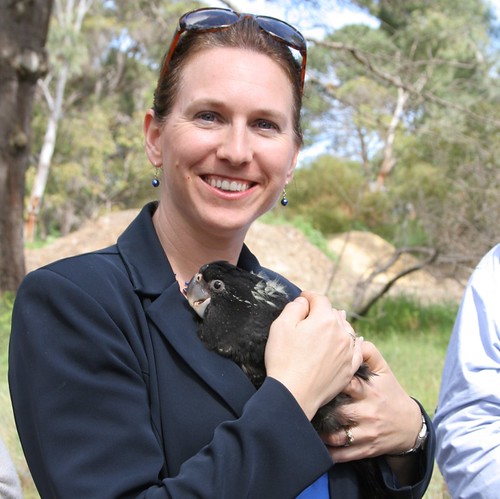 Caroline Minton with KaarakA threatened species of wild black cockatoo has produced a new chick at Murdoch University’s South Street Campus – only the second time the bird is thought to have bred in the Perth metropolitan area.
Caroline Minton with KaarakA threatened species of wild black cockatoo has produced a new chick at Murdoch University’s South Street Campus – only the second time the bird is thought to have bred in the Perth metropolitan area.
The Forest Red-tailed Black Cockatoo chick is believed to have hatched around six weeks ago in an artificial nesting box and is likely to join Little Red – the product of the first known case of a Forest Red-tailed Black Cockatoo breeding in the Perth metro area – on the wing around campus very soon.
The hatching is another success in the University’s ongoing plan to provide habitat for endangered wild cockatoos and is only the second known case of a Red-tail breeding in an artificial nest box.
The chick has been named Kaarak, which is the Nyungar name for Red-tails. It has been tagged and DNA samples have been collected to establish its sex and for general analysis.
“We are absolutely thrilled to welcome a second Red-tail chick onto campus,” said Murdoch University’s Environmental Program Manager Caroline Minton.
“This species is endemic to the South-West corner of Western Australia but is threatened because of a substantial loss of habitat over the last 50 years. A lack of suitable nesting hollows and food sources had previously stopped the cockatoo from breeding in the metro area but we hope the work we have done to create habitat for them on the South Street Campus will encourage more Red-tails and Carnaby’s cockatoos to breed here.”
The University has planted Banksias and various Eucalypts to try and attract black cockatoos to campus. It has also introduced reserves, native landscaping, extensive replanting and wildlife corridors.
Kaarak was born in one of the 11 open top nest boxes first attached to trees on campus in 2009 and 2011, which were funded by grants from the Department of Environment and Conservation.
“We have erected a further eight nesting boxes around the South Street Campus this week as well as six bat boxes for our resident microbats, so we are hopeful we can help to protect more native species,” said Ms Minton.
She added that nest boxes and bat boxes have also been erected at Murdoch’s regional campuses in Mandurah and Rockingham, all of which have been funded by the University.
The South Street Campus’ population of Red-tails is currently estimated at approximately 200 while Carnaby’s numbers vary between 30 in winter to up to 350-500 through summer, although numbers were much lower this year.
Feathers and faeces from the cockatoo were collected by Dr Nicole White from Murdoch University’s ancient DNA lab for forensic, species biology and conservation purposes. The samples will help to enhance scientists’ understanding of the genetic biodiversity of Red-tails and provide data on which trees and insects they are eating in and around campus.
Adjunct Murdoch University Professor and WA Museum’s Curator of Ornithology, Ron Johnstone, also collected samples as part of an ongoing research project that studies the breeding biology, migration movements, food and behaviour of all three species of black cockatoo, including the Baudin’s and Carnaby’s.